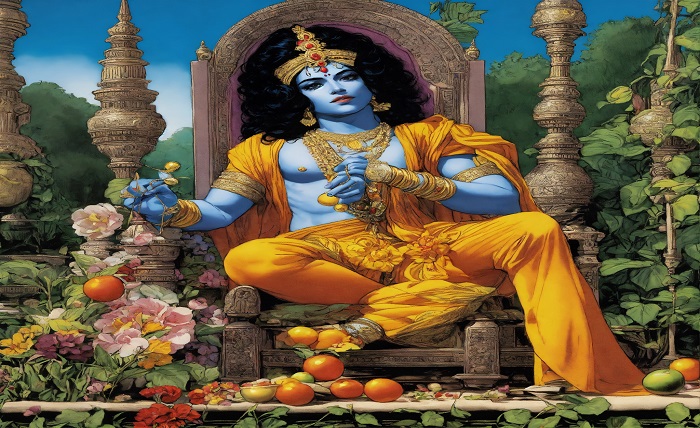In the vast and vibrant tapestry of Hindu devotional literature, few texts offer the concise yet profound depth of a Chalisa. The term ‘Chalisa’ originates from ‘chalis’, meaning forty, representing the forty verses that form the core of these beloved hymns. Among these, the Vishnu Chalisa holds a place of supreme reverence, dedicated to Lord Vishnu, the Preserver in the Holy Trinity. Chanting the Vishnu Chalisa is not merely a ritual; it is an immersive spiritual experience that connects the devotee directly with the divine energy of sustenance and harmony that Lord Vishnu embodies. This sacred hymn is a beautiful compilation of praises, prayers, and philosophical insights, each verse designed to purify the mind, attract divine grace, and guide the soul on its evolutionary journey. The power of the Vishnu Chalisa lies in its ability to condense the immense glory of the Supreme Preserver into forty accessible verses, making the divine accessible to everyone, from the seasoned scholar to the sincere seeker.
The Divine: Who is Lord Vishnu?
To fully appreciate the Vishnu Chalisa, one must first understand the deity it venerates. Lord Vishnu is one of the principal deities of Hinduism, forming the Trimurti with Brahma (the Creator) and Shiva (the Destroyer). Vishnu’s role is that of the Preserver and Protector of the universe. He is the cosmic force that maintains order (dharma), intervenes during times of cosmic crisis, and ensures the continuity of creation. He is often depicted as a serene, blue-skinned god, resting on the cosmic serpent Shesha Nag in the milky ocean, symbolizing his connection to the primordial waters of creation. In his four hands, he holds four iconic objects: the conch shell (Panchajanya), which represents the primordial sound of creation ‘Om’; the discus (Sudarshana Chakra), a symbol of the mind and divine power to destroy evil; the mace (Kaumodaki), representing mental and physical strength; and the lotus (Padma), a symbol of purity, beauty, and spiritual liberation. The Vishnu Chalisa beautifully elaborates on these attributes, helping the devotee visualize and connect with this magnificent form. The hymn also celebrates his ten major incarnations (Dashavatara), through which he descended to earth to restore cosmic balance, making the Vishnu Chalisa a also a celebration of his leelas (divine play).
The Origin and Significance of the Vishnu Chalisa
The exact historical origins of the Vishnu Chalisa, like many ancient devotional texts, are shrouded in the mists of time and are considered to be divinely inspired through great sages. It is written in Awadhi, a dialect of Hindi, and its composition is traditionally attributed to the devotion of countless saints and poets who poured their love for the divine into verse. The significance of the Vishnu Chalisa is multifaceted. Structurally, the number forty is itself considered potent in Hindu spirituality, representing completeness and a cycle of purification. Reciting the forty verses is believed to create a protective spiritual shield around the devotee. The Vishnu Chalisa serves as a comprehensive guide to Vishnu’s mythology, his qualities, and his benevolence. It is a tool for both bhakti (devotion) and jnana (knowledge). For a beginner on the spiritual path, it offers a structured way to pray, while for an advanced practitioner, it provides deep philosophical truths for contemplation. The significance of reciting the Vishnu Chalisa is profoundly personal, yet universally acknowledged as a source of immense positive energy and divine connection.
A Guide to Recitation: How to Chant the Vishnu Chalisa
While the sincere call of a devotee’s heart is always heard, following a traditional method of recitation can enhance the focus and spiritual benefits of chanting the Vishnu Chalisa. Ideally, chanting is done during the Brahma Muhurta, the auspicious period roughly an hour and a half before sunrise, when the mind is calm and the atmosphere is saturated with spiritual peace. However, any quiet time of day can be chosen. Begin by sitting in a clean, quiet space facing east or north. Take a few moments to calm your mind with some deep breaths. It is recommended to first invoke Lord Ganesha for removing obstacles by chanting a simple ‘Om Ganeshaya Namah’. Then, light a lamp (diya) and offer some flowers or incense to create a sacred atmosphere. Hold a copy of the Vishnu Chalisa respectfully in your hand or place it on a stand. Before starting the main hymn, it is beneficial to chant the Vishnu Sahasranama or simply chant the Vishnu Gayatri Mantra to tune your consciousness to Lord Vishnu’s frequency. Then, begin reciting the Vishnu Chalisa with clarity, devotion, and attention to the meaning of the verses. Chanting daily, with consistency, is considered far more powerful than occasional lengthy sessions.
The Spiritual and Material Benefits of Chanting the Vishnu Chalisa
The regular and devoted recitation of the Vishnu Chalisa bestows a multitude of benefits upon the seeker, affecting both their inner spiritual world and outer material life. On a spiritual level, the primary benefit is the cultivation of a deep, personal connection with Lord Vishnu, filling the heart with immense peace (shanti) and bliss (ananda). The vibrations of the sacred verses purify the mind, gradually reducing negative tendencies like anger, greed, and jealousy, and replacing them with sattvic (pure) qualities like compassion, patience, and clarity. The Vishnu Chalisa acts as a protective shield, guarding the devotee from negative energies, fears, and spiritual obstacles. On a material level, it is believed that sincere recitation can bring stability and harmony to one’s life, aligning circumstances with divine will. Devotees often experience relief from problems and find solutions to seemingly insurmountable challenges. The grace earned through chanting the Vishnu Chalisa is said to foster prosperity, safeguard one’s home and family, and create a positive aura that attracts auspiciousness. It is a holistic practice that nurtures both the soul and the life it is living.
Exploring the Verses: A Thematic Breakdown of the Vishnu Chalisa
The Vishnu Chalisa is a beautifully structured hymn that can be understood through its thematic progression. The initial verses are dedicated to paying homage and offering prayers to Lord Vishnu’s lotus feet, seeking his blessings for a successful recitation. The hymn then moves into a glorious description of his divine form—his dark complexion, his yellow garments, his radiant smile, and his four arms holding the sacred weapons. A significant portion of the Vishnu Chalisa is devoted to glorifying his ten incarnations (Dashavatara), including Matsya (the fish), Kurma (the tortoise), Varaha (the boar), Narsimha (the man-lion), Vamana (the dwarf), Parashurama, Rama, Krishna, Buddha, and Kalki. This section is not just a list but a celebration of his promise to protect dharma. The later verses humbly acknowledge the devotee’s shortcomings and pray for forgiveness, shelter, and ultimate liberation (moksha). The concluding verses, often called the phalashruti, describe the fruits of reciting the hymn, encouraging the devotee to engage with it faithfully. This thematic flow makes the Vishnu Chalisa a complete spiritual journey in itself.
Incorporating the Vishnu Chalisa into Your Daily Sadhana
Sadhana refers to a dedicated spiritual practice, and incorporating the Vishnu Chalisa into your daily routine can form a powerful cornerstone of that practice. Consistency is key. It is better to chant one time with full focus every day than to chant many times irregularly. You can attach the recitation to an existing habit, like right after your morning shower or evening meditation, to help build the routine. For those with extremely busy schedules, even listening to a melodious audio version of the Vishnu Chalisa during a commute can be immensely beneficial, as it immerses the mind in divine vibrations. Creating a small altar or dedicated space at home with an image or idol of Lord Vishnu can enhance the experience. As you chant, try to internalize the meaning of a few verses each day, contemplating how the qualities of Vishnu—preservation, harmony, protection—can manifest in your own life. This transforms the recitation from a mechanical repetition into a living, dynamic dialogue with the divine. Making the Vishnu Chalisa a part of your daily sadhana is an investment in your spiritual well-being that yields eternal dividends.
Conclusion
The Vishnu Chalisa is far more than a sequence of forty verses; it is a bridge between the human and the divine, a mantra for peace in a chaotic world, and a timeless guide to living a life aligned with dharma. Its words carry the vibrational essence of Lord Vishnu’s preserving, protective energy. Whether seeking material comfort, spiritual solace, or ultimate liberation, a devotee finds a friend, guide, and protector in this powerful hymn. By regularly and devotedly chanting the Vishnu Chalisa, we invite the energy of preservation into our lives, helping us to navigate challenges with grace, to protect what is good within and around us, and to ultimately remember our own divine nature. It is a gift from the sages, a direct line to the Supreme Preserver, waiting to be embraced by all.
FAQs
1. Do I need to be initiated by a guru to chant the Vishnu Chalisa?
No, the Vishnu Chalisa is an open devotional hymn that can be chanted by anyone, regardless of initiation. What matters most is sincerity, respect, and a pure heart.
2. What is the best time to recite the Vishnu Chalisa?
The most auspicious time is during Brahma Muhurta (early morning, before sunrise). However, it can be chanted at any time of day. The key is to choose a time when you can be focused and undisturbed.
3. How many times should I chant the Vishnu Chalisa for specific wishes?
While there is no fixed rule, many devotees chant it 1, 3, 7, or 108 times as part of a personal vow (sankalp) for 40 days (a mandala) to seek blessings for a specific purpose.
4. Can I listen to the Vishnu Chalisa if I cannot recite it?
Absolutely. Listening to the Vishnu Chalisa with devotion and attention is also highly meritorious and can create a peaceful, spiritually charged atmosphere.
5. Is there a difference between the Vishnu Chalisa and other Chalisas like the Hanuman Chalisa?
Yes, each Chalisa is dedicated to a specific deity and highlights their unique attributes, stories, and powers. The Vishnu Chalisa specifically glorifies Lord Vishnu, the Preserver, and his incarnations.




